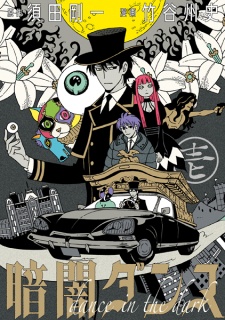Suda51, founder of developer Grasshopper Manufacture is one of my favourite figures in gaming. His punk sense of style and strange mixture of philosophy and dick jokes gives him a unique flavour even among Japan’s most quirky of creators. Unfortunately, not everyone of his projects has turned out the best. In the late 2000s Suda was working with a lot of western companies that definitely wanted to market his wacky Asian game maker status and not much else. One such work, ‘Shadows of the Damned’ was a fun third person shooter but lacked Suda51 more charming writing that went behind all the funny visuals. According
...
to Grasshopper Manufacture’s official art-book, a lot of this was due to the publisher EA’s (of course), heavy tampering with project, including insisting it had to be a shooter. Suda would however eventually get to tell his vision of Shadows of the Dammed in the form of a twisted surreal manga called ‘Kurayami Dance’.
In his original interviews Suda says that his idea of Kurayami (later to become Shadows) was that of the protagonist exploring a castle town coveted in darkness, heavily inspired by Franz Kafka’s novel ‘The Castle’. This overview is more or less the gist of Kurayami’s plot. Young undertaker Wataru Kaido (later known as Wataru Kamikaze) is in a “hurry to live”. He attempts to drive a motorcycle passed 300 mph to experience life at its peak. The inevitable crash from this stunt leaves him in a three-year coma. When he wakes up, he finds the city, Houdou City, completely deserted as everyone now works in Castle City, a brand-new high-end walled off city town complete with a giant cylinder like castle in the middle. The next day his boss asks him to perform a funeral right at the top of the castle for the royalty, so he gets going. From here he meets a cast of strange characters as he ascends through the city.
The first thing to note about the manga’s is its great use of artistic ambience. The world has a surreal visual style reminiscent of German expressionism. Buildings are curved and distorted, and characters are framed at strange angle and occasionally drawn out of proportion to make them seem larger and more daunting. This creates an effect of making the world more imposing. In Houdou city, it further adds to the feeling of emptiness and isolation with no one inhabiting such large structures. On the other hand, the chapters in Castle City are packed with a large variety of people, shops, service stands, signs, etc. Characters are presented from closer shots confined in visible walls, creating a more claustrophobic atmosphere. If Kurayami was supposed to be a game about darkness, that certainly followed into the manga as well. The series occasionally will rely on darkened panels, similar to dark deco styles where white characters will be drawn on black background paper. It creates a dynamic contrast and adds to the sinister dreamlike nature of the Castle.
The plot has a very Alice in Wonderland like structure with our main character Wataru making his way up the tower and meeting a cast of eccentric personalities along the way. The writing is filled with Suda’s usual quirks. Characters weave in and out of deep philosophical thoughts, to modern pop culture references to low brow sex jokes within pages in each other but there’s still a steady flow between the dialogue. The manga knows how to make characters eccentric enough to spark the reader’s attention, but it’s executed in a more casual chilled out manner making it easier to digest the bizarre nature of conversations.
With that being said, some sections can come off as a bit too strange for their own good. Suda like’s his abstract, interpretive storytelling and it shows. The manga can jump between dreams and reality and strange imagery or character twists can seemingly pop out of nowhere. If you’ve played Killer 7 or watched something like Serial Experiments Lain, you’ll be more used to it but it’s not a style for everyone.
I will say though that underneath all the surreal imagery is an aspect of realism. The character still talks and act in ways that real people would (at least most of the time) and their relationships and character development feel genuine. An example of this is when a woman rescues Wataru, has lunch with him at a cafe and then demands he marry her on the spot. It seems crazy, but the manga gives time for both characters to explain their motivations and in a strange way, I could kind of see where they're coming from and even start to get behind it.
Looking at broader topics, the manga combines Kafka’s themes of vague yet draconic bureaucracy and the crushing effect that it has on people’s psyche with recurring themes of Suda’s work like death, individuality and society. The people in the Castle City take death very lightly. They are willing to kill themselves over the most minuscule of misconduct and those that do die can be easily replaced with another ‘Tanaka’. When combined with the closed in feeling of the castle, it’s a pretty obvious but effective metaphor for the machine-like nature of the Japanese work force and disposability of those deemed inefficient. The manga outright says that the people working in the castle feel like they’re already died and that their current life is more like a ‘bonus’ check.
All of this clash with the views of our main character Wataru Kamikaze who is defined by his need to feel alive. As an undertaker, he deals with death daily and feels that he has to live life “in a hurry” meaning to experience everything he possible can. His hobby of high-speed motorcycle racing only further fuels his need to push himself to feel as alive as possible, since of course: when do you feel more alive than when you're closest to death. As the story continues this idea is tested by those living within the tower, leading Wataru to rethink his ideals and come to new conclusions about the relationship between life and death. He's also just a fun, witty straight man. Watching his snarky dialogue with luchador doctors and killer mascot assassins is entertaining to watch and presented in a comic but accessible fashion, once you look passed the madness of the context.
It is important to note that Suda himself worked as an undertaker before moving into game design. As such, the subject of death and playing with death without thinking of the consequences are seen throughout a lot of his games but Kurayami Death is probably where he’s gone the most in depth about it. It’s a strange little story filled with strange visuals and characters but like all of Suda’s best work it has meaningful writing and heart underneath. The characters are quirky but still down to earth enough to be likeable and the themes are well delivered even if a bit on the nose. Not all of it will make sense but I think that’s part of the fun with artsy farsty surrealist manga. If you’d think you’d like to go on a dark dream like trip, this is a good one to check out.
Ps: Also, if you like Suda’s other work, there’s a ton of Easter eggs from his games in this one. Even a certain assassin shows up, it’s really cool.
Alternative TitlesSynonyms: Dance of Darkness Japanese: 暗闇ダンス More titlesInformationType: Manga
Volumes: 2
Chapters: 16
Status: Finished
Published: Aug 12, 2015 to Nov 11, 2016
Demographic:
Seinen
Serialization:
Comic Beam Statistics Ranked: #26742 2 based on the top manga page. Please note that 'R18+' titles are excluded. Popularity: #8583
Members: 2,375
Favorites: 86 Resources | Reviews
Filtered Results: 3 / 5
Sort
Your Feelings Categories Jul 5, 2020
Suda51, founder of developer Grasshopper Manufacture is one of my favourite figures in gaming. His punk sense of style and strange mixture of philosophy and dick jokes gives him a unique flavour even among Japan’s most quirky of creators. Unfortunately, not everyone of his projects has turned out the best. In the late 2000s Suda was working with a lot of western companies that definitely wanted to market his wacky Asian game maker status and not much else. One such work, ‘Shadows of the Damned’ was a fun third person shooter but lacked Suda51 more charming writing that went behind all the funny visuals. According
...
Aug 9, 2020
Kurayami Dance is one of the most unique mangas I've ever read. It feels like someone's personality in both text and drawing are imbued into every page of this 2-volume story. It's one of my favorites not just because of the witty dialogue or the stunning art (which is what hooked me in the beginning), but also the concepts that, although seemingly distant from each other, are all closely aligned.
Premise: Wataru Kaido is an undertaker by day, motorcyclist at night, and in chapter 1 he seeks to go past 300 miles per hour on the mountain roads because he's "in a rush to live." ... Nov 13, 2018
Kurayami Dance or Dance in the Darkness, is a short manga, with only 20 chapters. It reads like a novel,ie. it is unlike your everyday manga, where there is a highschool, heroes, villains,etc.
Story: There story is surrealistic, we don't know what is true and what is a figment of imagination. Still, it is interesting. Had the manga stretched for more than 20 chapters, I might've been bored. Art: The art is clean, easy on the eyes. Characters: There is a protagonist, and a handful others, we don't spend much time with a character to relate. But this style suits this manga. ... |

